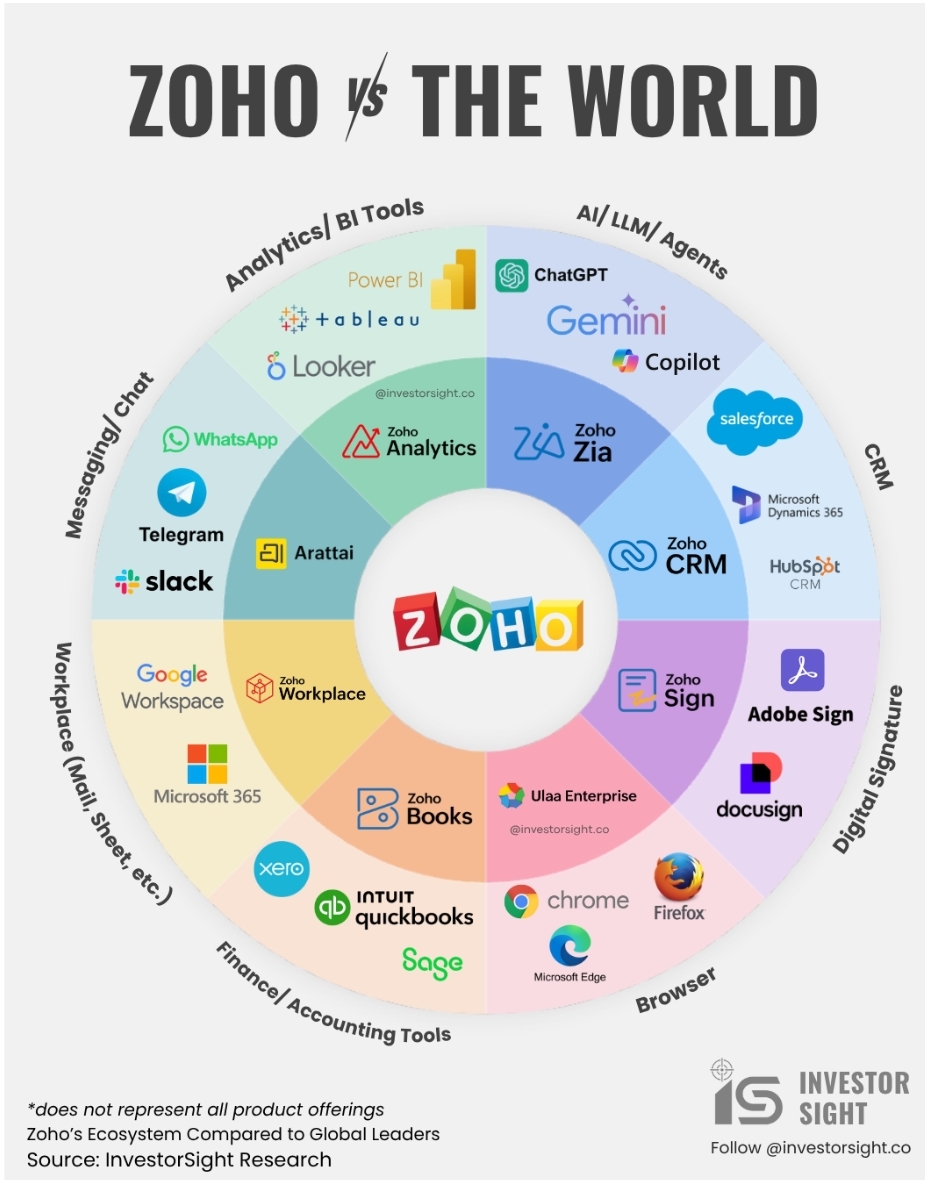Zoho Ecosystem vs. The World: Why Your Business Needs a Unified Ecosystem, Not More Point Solutions
Remember the last time you tried explaining your company’s tech stack to a new hire? You probably found yourself mentioning seven different logins, three data exports, and two manual workarounds. Sound familiar? Then, you definitely need to look into Zoho Ecosystem.
You’re experiencing the pain of software sprawl. Modern businesses juggle an average of 130 different applications. Each department champions its preferred tool. Marketing swears by HubSpot. Sales lives in Salesforce. Finance demands QuickBooks. IT struggles to keep them all connected.
This fragmented approach isn’t just inconvenient—it’s expensive, inefficient, and hurting your customer experience.
The Hidden Cost of Software Sprawl
Your tech stack is bleeding money. Companies spend up to 70% of their IT budget just maintaining existing systems. That leaves precious little for innovation. When Nucleus Research interviewed mid-market companies switching from Salesforce to Zoho, they discovered these organizations reduced their total cost of ownership by 42%.
The math is simple but shocking. A typical mid-size company might pay $165 per user monthly for Salesforce’s enterprise plan. Add integrations, training, and maintenance—you’re looking at substantial overhead. Zoho’s enterprise offering? $52 per user per month, with most integrations built-in.
Data silos destroy decision-making. Your customer service team can’t see marketing campaign data. Sales doesn’t know about support tickets. Finance operates with outdated inventory numbers. This disconnect costs more than money—it costs trust. When customers repeat their story three times to three different departments, they notice.
Integration nightmares multiply. Each new tool requires custom connections. API limits break workflows. Version updates break integrations. Your IT team spends more time playing digital plumber than driving business value.
Why Unified Platforms like Zoho Ecosystem Win
Smart companies are consolidating. Recent research shows 68% of CIOs plan to reduce their vendor count by 20% in 2025. They’re not just cutting costs—they’re gaining competitive advantages.
Single Source of Truth
Unified platforms like Zoho Ecosystem eliminate data duplication and inconsistencies. When everything connects natively, you get real-time visibility across operations. Your sales team sees support history. Marketing understands customer lifetime value. Finance tracks cash flow in context.
Zoho ecosystem demonstrates this perfectly. Their CRM automatically syncs with Zoho Books for accurate financial reporting. Marketing campaigns in Zoho Campaigns connect directly to lead scoring in Zoho CRM. Support tickets from Zoho Desk appear in customer profiles instantly.
Reduced Training Complexity
Learning one interface beats mastering five different systems. Zoho’s consistent design language means employees familiar with one application quickly adapt to others. Training time drops dramatically when your team isn’t context-switching between platforms.
Seamless Automation
Point solutions require complex integration work for basic automation. Unified platforms enable powerful workflows out-of-the-box. When a lead converts in Zoho CRM, it can automatically create a project in Zoho Projects, generate an invoice in Zoho Books, and send a welcome sequence through Zoho Campaigns—no custom coding required.
The Zoho Advantage: 45+ Apps, One Login, it’s Zoho Ecosystem
Zoho One represents the ultimate unified approach. For $50 per employee per month, you get access to 45+ business applications. This isn’t just software bundling—it’s architectural integration.
Compare the competition: Salesforce excels at CRM but requires separate purchases for marketing automation, support ticketing, and project management. Microsoft offers broad coverage but struggles with specialized functions like inventory management. Google Workspace handles collaboration well but lacks comprehensive business management tools.
Zoho covers everything: CRM, marketing automation, help desk, project management, accounting, inventory, HR, business intelligence, and more. Each application shares the same user interface, data model, and security framework.
Real-World Impact
Companies switching to Zoho’s unified approach report impressive results. Manual data entry drops by 63%. Reporting efficiency improves by 38%. Employee productivity increases significantly when they stop jumping between systems.
Consider the travel insurance company that replaced their disconnected contact center technology with a unified CX platform. They decreased abandon rates by 55%, reduced average speed to answer by 64%, and improved SLA performance by 28%. Most importantly, they cut claims processing time by 10 days.
Industry-Specific Benefits of Zoho Ecosystem
Different sectors see unique advantages from unified platforms:
Manufacturing companies appreciate integrated inventory management connecting to accounting and customer management. When raw materials arrive, the system automatically updates inventory levels, triggers production schedules, and adjusts customer delivery dates.
Professional services firms benefit from seamless project-to-billing workflows. Time tracking in projects automatically generates invoices with proper tax calculations and client-specific rates.
E-commerce businesses leverage unified platforms for inventory synchronization across multiple sales channels. When a product sells on your website, inventory updates instantly across marketplaces, preventing overselling.
The Integration Challenge Alternative
Traditional “best-of-breed” approaches promise superior functionality from specialized tools. The reality proves messier. Each integration point creates potential failure modes. API rate limits throttle data synchronization. Version mismatches break workflows.
Enterprise Strategy Group’s analysis reveals that companies avoid 25-50% of integration time and effort when choosing unified platforms over point solutions. They eliminate up to 70% of the maintenance overhead required for managing disconnected systems.
Security Simplified
Unified platforms reduce security complexity dramatically. Instead of managing dozens of different security policies, access controls, and audit trails, you maintain one comprehensive security framework. Single sign-on becomes effortless when applications share the same authentication system.
Data privacy compliance improves when customer information stays within one platform rather than syncing across multiple vendors with different privacy policies.
Making the Transition
Switching from scattered point solutions to a unified platform requires careful planning. Start with your biggest pain points. Most companies begin with core business functions—CRM, accounting, and project management—then expand gradually.
Phase 1: Foundation – Implement unified CRM and accounting systems. These core functions touch most business processes and provide immediate integration benefits.
Phase 2: Operations – Add inventory management, support ticketing, and marketing automation. Connect these to your foundation applications for automated workflows.
Phase 3: Enhancement – Integrate HR, business intelligence, and specialized tools. By this stage, you’ll have established unified data patterns and user adoption momentum.
Change Management Considerations
Employee resistance often determines project success more than technical capabilities. Unified platforms typically reduce this resistance because users learn one interface instead of many. However, clear communication about benefits and comprehensive training remain essential.
Focus on workflow improvements rather than feature comparisons. Show employees how unified platforms eliminate their current frustrations—duplicate data entry, manual exports, and information hunting across systems.
The AI Multiplication Effect
Artificial intelligence amplifies unified platform benefits. AI models require high-quality, integrated data to deliver valuable insights. Disconnected systems with inconsistent data formats limit AI effectiveness.
Unified platforms provide the data foundation AI needs. When customer interactions, financial transactions, and operational metrics share common data models, AI can identify patterns impossible to detect in siloed systems.
Zoho’s AI assistant, Zia, demonstrates this advantage. Because it accesses integrated data across the entire platform, Zia can provide insights spanning sales, marketing, support, and finance. Point solutions with separate AI tools can’t achieve this comprehensive analysis.
Future-Proofing Your Technology Stack
Technology continues evolving rapidly. New communication channels emerge. Regulations change. Market conditions shift. Unified platforms adapt more easily than collections of point solutions.
When Apple announced new privacy policies affecting digital marketing, companies using unified platforms quickly adjusted their entire customer journey tracking. Organizations dependent on multiple disconnected marketing tools struggled to maintain campaign effectiveness across the transition.
Scalability Advantages
Growing businesses face a crucial decision point. Do you add more point solutions as needs expand, or do you choose platforms that scale with your growth? Unified platforms typically handle increased volume, users, and complexity more gracefully than fragmented approaches.
Zoho serves companies from startup stage through enterprise scale. The same foundational platform accommodates 10 employees or 10,000 without architectural changes.
Key Takeaways for CX Leaders
Modern customer experience demands unified operations. Customers interact across multiple touchpoints expecting consistent, personalized service. Disconnected systems make this impossible.
Start with integration assessment. Map your current technology landscape. Identify manual processes created by system gaps. Calculate the true cost of your current approach including integration maintenance, training, and operational inefficiency.
Prioritize platforms over tools. When evaluating new solutions, consider their integration capabilities with your entire technology ecosystem. Purpose-built platforms often provide better long-term value than seemingly superior point solutions.
Think strategically about data. Unified platforms create valuable data assets. Customer journey insights, operational analytics, and predictive capabilities emerge naturally from integrated systems. These advantages compound over time.

The choice isn’t really between Zoho and individual competitors like Salesforce, Microsoft, or Google. It’s between unified operations and fragmented workflows. In an increasingly competitive business environment, the companies that can act on complete information fastest will win.
Your customers expect seamless experiences. Your employees deserve efficient tools. Above all, our bottom line needs optimized operations. Unified platforms deliver all three advantages while positioning your organization for future growth and innovation.
The question isn’t whether to consolidate your technology stack. It’s whether you’ll lead this transition or be forced to catch up later.


